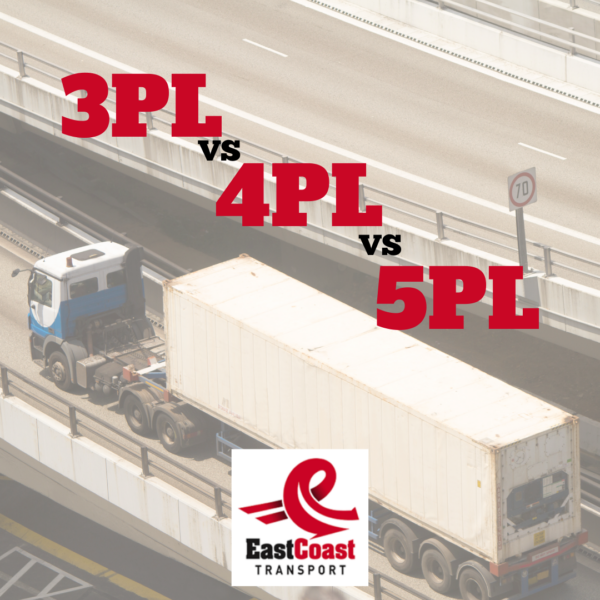In the fast-paced world of logistics and supply chain management, choosing the right service provider can significantly impact the efficiency and success of your operations. The logistics industry has evolved to offer a range of solutions, including 3PL (Third-Party Logistics), 4PL (Fourth-Party Logistics), and 5PL (Fifth-Party Logistics) services. In this comprehensive guide, East Coast Transport will explore the differences between these logistics providers, helping you make informed decisions that align with your business goals.
3PL vs 4PL vs 5PL
Understanding the distinctions between 3PL, 4PL, and 5PL logistics services is vital for optimizing your supply chain operations. Depending on your company’s needs, you can choose the level of logistics support that aligns best with your strategic goals and operational requirements. Whether it’s the operational focus of a 3rd party logistics, the integrated approach of a 4th party logistics, or the strategic consultancy of a 5PL, these logistics services play pivotal roles in today’s complex supply chain landscape.
What is 3PL? (Third-Party Logistics)
A 3PL company acts as an external service provider, managing various logistics functions on behalf of a company. These functions include full freight management, intermodal transportation, reefer trucking, and more.
Advantages of Third-Party Logistics
- Operational Focus: third-party logistics companies primarily concentrate on day-to-day logistics operations, including transportation management and warehouse operations.
- Single Point of Contact: They serve as intermediaries between the shipper and multiple logistics service providers, simplifying the logistics process.
Customized Solutions: 3PLs offer tailored solutions, adapting to clients’ specific logistics needs. - Expertise: 3PL organizations are experts in supply chain logistics and offer their experience and connections to streamline processes for their clients.
International Shipping: They provide insights into issues that can arise during international shipping. - Cost Savings: Using a 3rd party logistics providers can potentially eliminate the need to invest in warehouse space, technology, transportation, and employees for logistics processes, allowing for more focus on core competencies.
East Coast Transport is a leading 3PL Company in the New Jersey area with 40 years of industry expertise. With our 3rd party logistics services, you can focus on growing your business with confidence and peace of mind that East Coast Transport is successfully delivering your products on time.
What is 4PL? (Fourth-Party Logistics)
While a 3PL company manages various aspects of fulfillment, a 4PL provider assumes responsibility for overseeing a 3PL on behalf of the client and managing additional components of the complete supply chain.
Fourth-party logistics embodies a strategic business model where a company entrusts the entirety of its supply chain management and logistics to an external service provider. A 4PL company adopts a comprehensive approach to logistics by integrating diverse supply chain functions, often serving as the central point of control.
Advantages of Fourth-Party Logistics
- Strategic Focus: 4PLs focus on long-term supply chain strategy and optimization, often overseeing multiple 3PLs to ensure seamless operations.
- End-to-End Integration: These providers integrate the entire supply chain, from suppliers to end customers, enhancing visibility and efficiency.
- Technology-Driven: 4PLs leverage advanced technology to optimize logistics processes and decision-making.
- Streamlined Solution: These providers handle everything in your logistics operations, ultimately saving time, resources, and costs.
What is 5PL? (Fifth-Party Logistics)
5PL companies take logistics outsourcing to the next level, combining logistics management with strategic consultancy, often leveraging emerging technologies like AI and data analytics.
A 5PL provider leverages technology to assist companies driven by e-commerce, with a reduced physical presence. They combine logistics services for multiple customers to achieve cost savings, incorporating technologies like blockchain, robotics, automation, and RFID devices.
Advantages of Fifth-Party Logistics
- Fully Integrated Approach: 5PLs provide a comprehensive view of the supply chain, encompassing logistics, procurement, and strategic business decisions.
- Strategic Partnerships: They cultivate deep partnerships with clients, becoming an extension of their organization rather than just a service provider.
- Innovative Solutions: 5PLs harness cutting-edge technologies to optimize supply chain performance and drive innovation.
Linking First-party logistics to Fifth-Party Logistics
The logistics industry offers a range of services, from 1PL to 5PL. These terms represent the number of parties involved in the logistics of moving a product from the beginning of the supply chain to the end consumer or retailer. The boundaries between the logistics providers can blur as they collaborate for integrated solutions. For example, 4PL Companies and 5PL Companies often collaborating with multiple 3rd Party Logistics Companies to optimize results for their clients. As businesses progress up the PL ladder, they can focus more on core functions while outsourcing logistics processes.
Finding the Right Logistics Strategy for Your Business:
Selecting the appropriate logistics provider(s) depends on your business structure and strategy. Consider factors such as the size, structure, and goals of your business when making your choice.
At East Coast Transport, we specialize in 3PL. We’ll meet your deadlines and customize operations in order to provide you safe and on-time delivery. We’ll communicate with you from start to finish, every time. With our unlimited resources, 24-hour freight tracking and tracing, temperature monitoring for perishable products, and competitive rates, we are the strategic logistics partner you need. Get a free transportation quote today.

